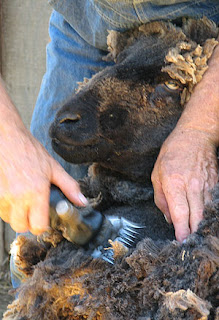Shearing day
 Once a year, in the spring, the shearer passes through to Oldham County, stopping at a few farms that keep sheep and goats. We usually get a call the day before, and then scramble to get ready. The first task is always the same, get the sheep put up – it’s a precarious operation.
Once a year, in the spring, the shearer passes through to Oldham County, stopping at a few farms that keep sheep and goats. We usually get a call the day before, and then scramble to get ready. The first task is always the same, get the sheep put up – it’s a precarious operation.We have Merino sheep, a very skittish breed, but to our luck they are also creatures of habit. Each evening we feed them a little grain in their shed and the habit is set. They know when we enter the field gate with a bucket in hand that it’s time to eat. Usually they go in the shed and we simply lock the gate, but last evening something broke the rhythm of the routine and they would not go near their shed. So we went with plan B, which involves three people and six walking sticks. My wife, daughter and I went into the sheep field, strategically placed ourselves like wolves, and then with a walking stick in each hand, held at arms length, starting chasing the sheep around trying to herd them into their shed. To the sheep the walking sticks make us look very big. It’s a silly thing to see, three people running around chasing sheep – which can run very fast when they want to. We succeeded, one or two sheep at a time, and made ready for shearing.
 The shearer shows up in an old van, a farmer in bibbed overalls, weathered face, massive hands and just a few teeth in his head. He could walk into the 1930s and no one would think him out of place.
The shearer shows up in an old van, a farmer in bibbed overalls, weathered face, massive hands and just a few teeth in his head. He could walk into the 1930s and no one would think him out of place.Shearing usually goes like this: I go into the shed and pull a sheep out. That steps sounds simple, doesn’t it? But you have to remember, these sheep weigh about 130 or 140 pounds, they are scared, they are strong and they have a very low center of gravity. It’s a struggle during which I say many bad words in my mind. Next, we take off the old coats (see my previous article on Merino sheep for why they wear coats). Of course it’s difficult. Then the shearer goes to work.
 There is a phrase, “like sheep to the slaughter.” The transformation is surprising – in the hands of the shearer the sheep no longer struggle. Our shearer takes about five minutes to shear the wool into a fleece. It’s difficult to explain the process – the shearer practically peels the wool off the sheep, strategically leaving the belly wool on the outside. When he is done, we fit the sheep with a new coat, and then my wife “skirts” the fleece, that is, she picks around the outside edges removing the dirty belly wool – it is where the term “Skirting the issue” came from.
There is a phrase, “like sheep to the slaughter.” The transformation is surprising – in the hands of the shearer the sheep no longer struggle. Our shearer takes about five minutes to shear the wool into a fleece. It’s difficult to explain the process – the shearer practically peels the wool off the sheep, strategically leaving the belly wool on the outside. When he is done, we fit the sheep with a new coat, and then my wife “skirts” the fleece, that is, she picks around the outside edges removing the dirty belly wool – it is where the term “Skirting the issue” came from.Next, four more sheep…it’s a good job to have over.


1 Comments:
I'm not sure if you meant this post to be funny...but I laughed pretty hard!
Post a Comment
<< Home